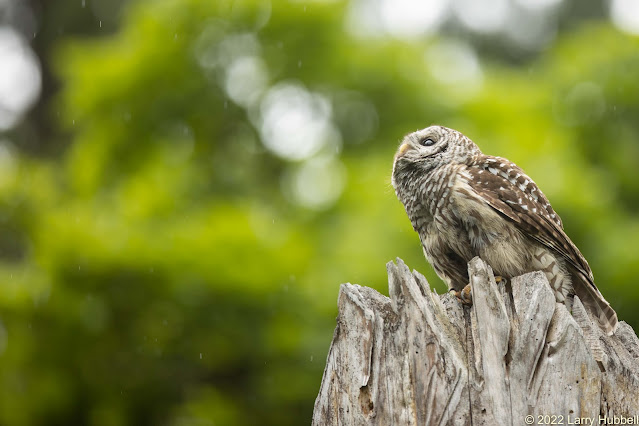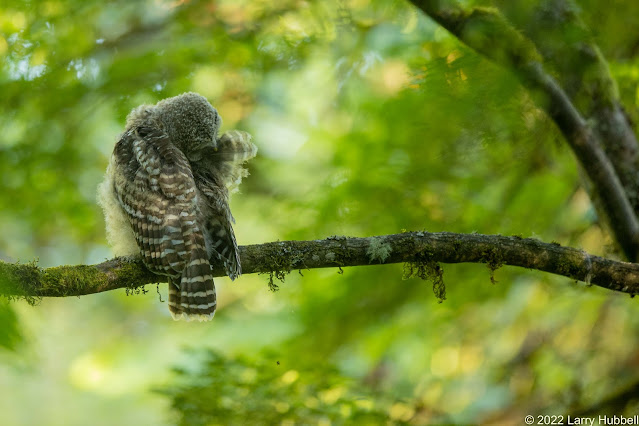Very young Barred Owls are incredibly cute and very vulnerable. When they first leave the nest they are typically unable to fly. While learning, they often fall to the ground where they are easy targets for coyotes, raccoons, and even off-leash pets.
Their only escape is to waddle to the base of a tree and claw their way up - one vertical step at a time. Their sharp talons help them to essentially walk up the tree trunk. This is a slow, intense process. They often stop to rest. Occasionally, they resort to using their bills to help facilitate their ascent.
I suspect this young owlet was using its wings for balance not lift. (This was my first time seeing a tree-hugging Barred Owl.)
Ultimately, the young owl crawled up to a sizable horizontal branch. Large, level branches hidden below a thick upper canopy are one of the safest places for a young owl to hang out. They also make nice tables. In the Arboretum, the mid-level branches on Big Leaf Maples trees are often used by Barred Owls, Cooper's Hawks, and Common Ravens as dining platforms.
The short, white-trimmed feathers, towards the center of the bird, are the owlet's tail. I am guessing the tail is maybe an inch or two long. I do not know the exact pace of rectrices growth. However, later in this post, we will see photos that imply rapid lengthening of the tail feathers once the young leave the nest.
The parents actively watch out for their young.
In this case, the adults paid particularly close attention to a Cooper's Hawk that was calling loudly from the nearby trees.
Finally, one of the adult owls grew impatient and chased the noisy young hawk away.
This particular young Cooper's Hawk was banded near its natal nest in Miller Park last July. Thank you to Martin, Ed, and Patti who lead the Urban Raptor Conservancy. They have been banding raptors in the city for years while developing and sharing an incredible wealth of knowledge. To learn more visit their website: Urban Raptor Conservancy.
The young owl turned and walked toward the parent.
Often both parents were in the tree but they do need to leave to find food.
Can you tell what is on the menu? (The answer will be mentioned below.)
Owlets need a nearly constant supply of food. They don't seem to be particular about the species.
After a few exploratory bites, the young owl attempted to just swallow the body of the bird.
Don't try this at home. We are simply not equipped for this approach to food consumption. It does make eating much faster and safer for predators. They rapidly internalize their food, leaving digestion for later and freeing them to escape harassment.
Repeatedly, the owlet threw its head back. Slowly, one millimeter at a time, the Spotted Towhee's body began its final descent.
Bones, meat, feathers, and feet all go down together. The indigestible parts will be regurgitated later.
***********
Thank You to everyone who has provided tips that helped me find the owlets. The list includes Roy, Ron, Tom, Bethany, Mindy, and Dan. (If I have omitted your name please excuse my memory lapse.) All your help is truly appreciated!
***********
A week later I finally found two more young owls that belonged to the pair of Barred Owls in the next territory to the north.
Notice that this young owl's tail is considerably longer than the owlet in the previous photos even though it is still molting out of its youthful fluffy white feathers.
I am guessing it has been out of the nest for at least three or four weeks. It is already flying, but learning to hunt will take sometime.
When its parent caught breakfast the adult ate most of the meal before picking up the leftovers and looking for the juvenile owl.
The young owl accepted the food readily. The meager offering did not appear to be enough to satiate its hunger. The adult must walk a fine line between helping the young one to survive and not reducing its motivation to hunt. By winter, the young will be on their own and their survival will be determined primarily by their hunting skills.
Have a great day on Union Bay...where nature lives in the city!
Larry
Going Native:
Each of us, who breathe the air and drink the local water, needs to watch and protect our local environment. Native plants and trees encourage the largest diversity of lifeforms because of their long intertwined history with our local environment and native creatures. Even the microbes in the soil are native to each local landscape.
I hope we can inspire ourselves, our neighbors, and local businesses to respect native flora and support native wildlife at every opportunity. I have learned that our most logical approach to native trees and plants (in order of priority) should be to:
1) Learn and leave established native flora undisturbed.2) Remove invasive species and then wait to see if native plants begin to grow without assistance. (When native plants start on their own, then these plants or trees are likely the most appropriate flora for the habitat.)3) Scatter seeds from nearby native plants in a similar habitat.4) If you feel you must add a new plant then select a native plant while considering how the plant fits with the specific habitat and understanding the plant's logical place in the normal succession of native plants.
***************
My friend Elaine Chuang shared several resources (that were new to me) from the January 2022 Washington Ornithological Society meeting. The major new concept is that specific keystone native plants enable critical moths and caterpillars that in turn provide food for the great majority of birds, especially during the breeding season. Here are the top two links from her list.
Native Keystone Plants for Wildlife:
https://www.youtube.com/watch?v=O5cXccWx030
Resources for adding plants to your Pacific Northwest Garden:
https://wos.org/wos-wp/wp-content/uploads/2021/12/native-plant-resources-v2.pdf
***************
In the area below it is my intention to display at least one photo each week to help challenge us to know the difference between native and non-native lifeforms.
Scroll down for the answer.
******************
Harpaphe haydeniana: This millipede is native to our area and very important to the ecology of our local forests. Click Here to read about how it processes pine needles and also uses cyanide.
*****************
The Email Challenge:
In response, I have set up my own email list. With each post, I will manually send out an announcement. If you would like to be added to my personal email list please send me an email requesting to be added. Something like:
Larry, I want to see more of nature. Please add me to your personal email list.
Thank you for your patience and interest!
Another common issue is losing your input while attempting to leave a comment on this blog. Often everything functions fine, however, sometimes people are unable to make it past the robot-detection challenge or maybe it is the lack of a Google account. I am uncertain about the precise issue. Sadly, a person can lose their comment with no recovery recourse.
My email address is:
LDHubbell@comcast.net
*******************
The Comment Challenge:
Bottom Line:
If you write a long comment, please, copy it before hitting enter. Then, if the comment function fails to record your information, you can send the comment directly to me using email.
My email address is:
LDHubbell@comcast.net
Sincerely,
Larry
Final Photos:
A few days after the photos of the first owlet above I caught this image of one of the adults in the same territory. What is stunning here is the total lack of tail feathers. I doubt that Barred Owls would naturally loose all their tail feathers at once, even during the molting process. I suspect there may have been a close encounter with a larger predator. Perhaps this owl was lucky to only loose its tail feathers.
This is the other adult in the same territory on the same morning. Notice that its tail feathers are worn but exist and totally hide the dark "v" shape on what I believe are the under tail coverts in the prior photo.























Your photos--amazing!
ReplyDeleteHeck, his posts--AMAZING! Thank you Larry.
ReplyDelete